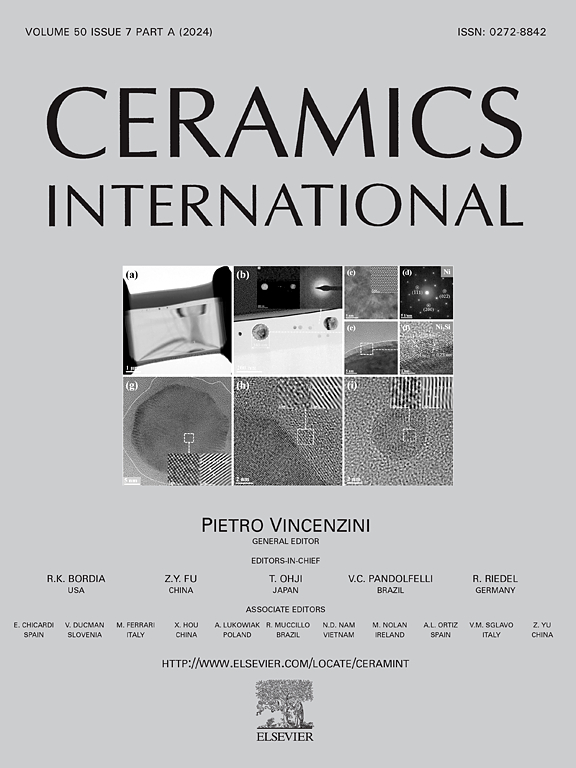Investigation of mechanical and chemical durability properties of oxide modifiers incorporated tellurite glass: Ternary oxide glass
IF 5.6
2区 材料科学
Q1 MATERIALS SCIENCE, CERAMICS
引用次数: 0
Abstract
Commonly believed, glass is more chemically durable than the majority of other materials. However, corrosion occurs when a glass piece is exposed to a liquid solution. This study investigates the durability and mechanical properties of zinc tellurite glasses as a function of their chemical composition for different oxide modifiers (Na2O, B2O3, CaO, and P2O5). Glasses systems based on 60TeO2-30ZnO-10Na2O (TZN), 75TeO2-10ZnO-15 B2O3 (TZB), 70TeO2-10ZnO-20CaO (TZC) and 75TeO2-15ZnO-10P2O5 (TZP) reported here were prepared by melt-quenching technique. The amorphous nature of the prepared glasses is tested using the X-ray diffraction (XRD) technique. The glasses' hardness (HV) and tensile strength were examined by microhardness Vickers's indentation. Phosphate as an oxide modifier content significantly impacts the glass's hardness, TZP glass possesses the highest hardness, 698.7 HV. The chemical durability of the glass was performed by immersing it in a sulfuric acid solution with a pH of 2 for 15 days. Microstructural characterization was performed using scanning electron microscopy (SEM) to study the morphology and structural changes of the glass samples. The attractive characteristics of chemical stability and enhanced mechanical properties suggest that the TZP glass can be designated as a suitable host for long-life optoelectronic applications that perform well in various environments.
含氧化改性剂的碲酸盐玻璃的机械和化学耐久性研究:三元氧化玻璃
人们普遍认为,玻璃在化学上比大多数其他材料更耐用。然而,当玻璃片暴露在液体溶液中时,就会发生腐蚀。本研究考察了不同氧化物改性剂(Na2O、B2O3、CaO和P2O5)化学成分对碲酸锌玻璃耐久性和机械性能的影响。采用熔淬法制备了60TeO2-30ZnO-10Na2O (TZN)、75TeO2-10ZnO-15 B2O3 (TZB)、70TeO2-10ZnO-20CaO(台州学院)和75TeO2-15ZnO-10P2O5 (TZP)玻璃体系。利用x射线衍射(XRD)技术测试了所制备玻璃的非晶态性质。采用显微维氏压痕法测定了玻璃的硬度和抗拉强度。磷酸盐作为氧化物改性剂的含量显著影响玻璃的硬度,TZP玻璃的硬度最高,达到698.7 HV。将玻璃浸泡在pH值为2的硫酸溶液中15天,测试玻璃的化学耐久性。利用扫描电子显微镜(SEM)对玻璃样品进行微观结构表征,研究其形貌和结构变化。具有化学稳定性和增强机械性能的诱人特性表明,TZP玻璃可以被指定为在各种环境中表现良好的长寿命光电应用的合适载体。
本文章由计算机程序翻译,如有差异,请以英文原文为准。
求助全文
约1分钟内获得全文
求助全文
来源期刊

Ceramics International
工程技术-材料科学:硅酸盐
CiteScore
9.40
自引率
15.40%
发文量
4558
审稿时长
25 days
期刊介绍:
Ceramics International covers the science of advanced ceramic materials. The journal encourages contributions that demonstrate how an understanding of the basic chemical and physical phenomena may direct materials design and stimulate ideas for new or improved processing techniques, in order to obtain materials with desired structural features and properties.
Ceramics International covers oxide and non-oxide ceramics, functional glasses, glass ceramics, amorphous inorganic non-metallic materials (and their combinations with metal and organic materials), in the form of particulates, dense or porous bodies, thin/thick films and laminated, graded and composite structures. Process related topics such as ceramic-ceramic joints or joining ceramics with dissimilar materials, as well as surface finishing and conditioning are also covered. Besides traditional processing techniques, manufacturing routes of interest include innovative procedures benefiting from externally applied stresses, electromagnetic fields and energetic beams, as well as top-down and self-assembly nanotechnology approaches. In addition, the journal welcomes submissions on bio-inspired and bio-enabled materials designs, experimentally validated multi scale modelling and simulation for materials design, and the use of the most advanced chemical and physical characterization techniques of structure, properties and behaviour.
Technologically relevant low-dimensional systems are a particular focus of Ceramics International. These include 0, 1 and 2-D nanomaterials (also covering CNTs, graphene and related materials, and diamond-like carbons), their nanocomposites, as well as nano-hybrids and hierarchical multifunctional nanostructures that might integrate molecular, biological and electronic components.
 求助内容:
求助内容: 应助结果提醒方式:
应助结果提醒方式:


